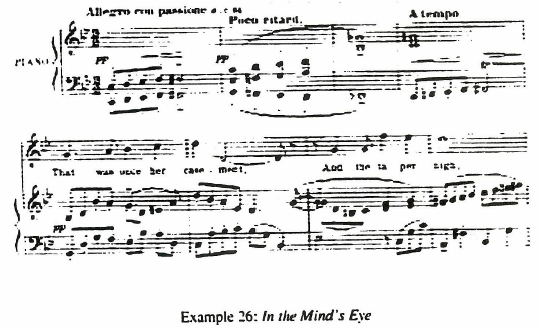In the Mind's Eye
Poet: Thomas Hardy
Date of poem:
Publication date:
Publisher:
Collection:
History of Poem:
Poem
In the Mind's Eye |
||
|---|---|---|
| 1 | That was once her casement, | |
| 2 | And the taper nigh, | |
| 3 | Shining from within there, | |
| 4 | Beckoned, 'Here am I!' | |
| 5 | Now, as then, I see her | |
| 6 | Moving at the pane; | |
| 7 | Ah; 'tis but her phantom | |
| 8 | Borne within my brain? - | |
| 9 | Foremost in my vision | |
| 10 | Everywhere goes she; | |
| 11 | Change dissolves the landscapes, | |
| 12 | She abides with me. | |
| 13 | Shape so sweet and shy, Dear, | |
| 14 | Who can say thee nay? | |
| 15 | Never once do I, Dear, | |
| 16 | Wish thy ghost away. | |
(Hardy, 226) |
||
Content/Meaning of the Poem:
Speaker:
Setting:
Purpose:
Idea or theme:
Style:
Form:
Synthesis:
Published comments about the poem:
✦✼✦✼✦✼✦✼✦✼✦✼✦✼✦✼✦✼✦✼✦✼✦✼✦✼✦✼✦✼✦✼✦✼✦
✦✼✦✼✦✼✦✼✦✼✦✼✦✼✦✼✦✼✦✼✦✼✦✼✦✼✦✼✦✼✦✼✦✼✦
Musical Analysis
Composition date:
Publication date:
Publisher: Boosey & Hawkes - Distributed by Hal Leonard Corporation
Tonality:
Transposition:
Duration:
Meter:
Tempo:
Form:
Rhythm:
Melody:
Texture:
Vocal Range:
Tessitura:
Dynamic Range:
Accompaniment:
Published comments about the music:
Pedagogical Considerations for Voice Students and Instructors:
✦✼✦✼✦✼✦✼✦✼✦✼✦✼✦✼✦✼✦✼✦✼✦✼✦✼✦✼✦✼✦✼✦✼✦
✦✼✦✼✦✼✦✼✦✼✦✼✦✼✦✼✦✼✦✼✦✼✦✼✦✼✦✼✦✼✦✼✦✼✦
| Pitch Analysis | ||||||
|---|---|---|---|---|---|---|
| pitch | stanza 1 |
stanza 2 |
stanza 3 |
stanza 4 |
total | |
highest |
A |
|||||
G |
||||||
F |
||||||
E |
||||||
D |
||||||
middle C |
||||||
B |
||||||
A |
||||||
G |
||||||
F |
||||||
lowest |
E |
|||||
| Rhythm Duration Analysis of Vocal Line | |||||
|---|---|---|---|---|---|
| stanza 1 | stanza 2 | stanza 3 | stanza 4 | total | |
16th note |
|||||
8th note |
|||||
dotted 8th |
|||||
quarter note |
|||||
dotted quarter |
|||||
triplet |
|||||
half note |
|||||
dotted half |
|||||
stanza total |
|||||
✦✼✦✼✦✼✦✼✦✼✦✼✦✼✦✼✦✼✦✼✦✼✦✼✦✼✦✼✦✼✦✼✦✼✦
Audio Recordings
To a Poet |
|
|
|
The Songs of Gerald Finzi to Words by Thomas Hardy
|
|
|
|
Gerald Finzi |
|
|
|
The English Song Series - 12 |
|
|
|
The following are comments by Chia-wei Lee regarding the song In The Mind's Eye. Dr. Lee extended permission to post this excerpt from his dissertation on February 16, 2012. His dissertation dated 2003, is entitled:
A Performance Study of Gerald Finzi's Song Cycle
"Before and After Summer"
This excerpt begins on page 84 and concludes on page 85.
The preceding were comments by Chia-wei Lee regarding the song In The Mind's Eye. Dr. Lee extended permission to post this excerpt from his dissertation on February 16th, 2012. His dissertation dated 2003, is entitled:
A Performance Study of Gerald Finzi's Song Cycle
"Before and After Summer"
The excerpt began on page 84 and concluded pn page 85.
The following is an analysis of **** by Gerhardus Daniël Van der Watt. Dr. Van der Watt extended permission to post this excerpt from his dissertation on October 8th, 2010. His dissertation dated November 1996, is entitled:
The Songs of Gerald Finzi (1901-1956) To Poems by Thomas Hardy
This excerpt comes from Volume II and begins on page *** and concludes on page ***. To view the methodology used within Dr. Van der Watt's dissertation please refer to: Methodology - Van der Watt.
1. Poet
Specific background concerning poem:
2. Poem
Setting
1. Timbre
VOICE TYPE/RANGE
2. Duration
METRE
Rhythmic motifs
Rhythmic activity vs. Rhythmic stagnation
Rhythmically perceptive, erroneous and interesting settings
Lengthening of voiced consonants
3. Pitch
Intervals: Distance distribution
Interval |
Upwards |
Downwards |
Unison |
||
Second |
||
Third |
||
Fourth |
||
Fifth |
||
Sixth |
||
Seventh |
Interval |
Bar no. |
Word/s |
Reason/s |
Melodic curve
Climaxes
System no. |
Pitch |
Word |
Phrase lengths
System no. |
From - To |
Suggested reason/s |
Chromaticism
HARMONY AND COUNTERPOINT
Non-harmonic tones
Harmonic devices
Counterpoint
FREQUENCY
RANGE
VARIETY
DYNAMIC ACCENTS
No. of parts |
No. of beats |
Percentage |
2 parts |
||
3 parts |
||
4 parts |
||
5 parts |
||
6 parts |
7. Mood and atmosphere
General comment on style
Unpublished Analysis Excerpts
The following is an analysis of In the Mind's Eye by Curtis Alan Scheib. Dr. Scheib extended permission to post this excerpt from his dissertation on February 17th, 2012. His dissertation dated 1999, is entitled:
Gerald Finzi's Songs For Baritone On Texts By Thomas Hardy: An Historical And Literary Analysis And Its Effect On Their Interpretation
This excerpt begins on page sixty and concludes on page sixty-one.
In the Mind's Eye |
||
|---|---|---|
| That was once her casement, | ||
| And the taper nigh, | ||
| Shining from within there, | ||
| Beckoned, 'Here am I!' | ||
| Now, as then, I see her | ||
| Moving at the pane; | ||
| Ah; 'tis but her phantom | ||
| Borne within my brain? - | ||
| Foremost in my vision | ||
| Everywhere goes she; | ||
| Change dissolves the landscapes, | ||
| She abides with me. | ||
| Shape so sweet and shy, Dear, | ||
| Who can say thee nay? | ||
| Never once do I, Dear, | ||
| Wish thy ghost away. | ||
(Hardy, 226)
|
||
Hardy's phantom returns, this time in a far gentler guise, but no less haunting or desired. Finzi's setting is in G minor, though it begins in C minor and ends in D minor. There is a modified strophic form at work here, matching the even shape of Hardy's verse. The first three stanzas are introduced by a similar figure in the piano, a rising eighth note pattern in the bass followed by a half note trill (example 26).

The rising eighth figure appears in other places in the accompaniment as well, often reversing directions. For the last verse, the eighth motion slows to quarters and a more lyrically shaped vocal line appears for "shape so sweet and shy, Dear." Finally, the spell seems broken at the mention of "ghost" as the tonality unsettles, like the vision, to D minor.
The preceding was an analysis of In the Mind's Eye by Curtis Alan Scheib. Dr. Scheib extended permission to post this excerpt from his dissertation on February 17th, 2012. His dissertation dated 1999, is entitled:
Gerald Finzi's Songs For Baritone On Texts By Thomas Hardy: An Historical And Literary Analysis And Its Effect On Their Interpretation
The excerpt began on page sixty and concluded on page sixty-one.




